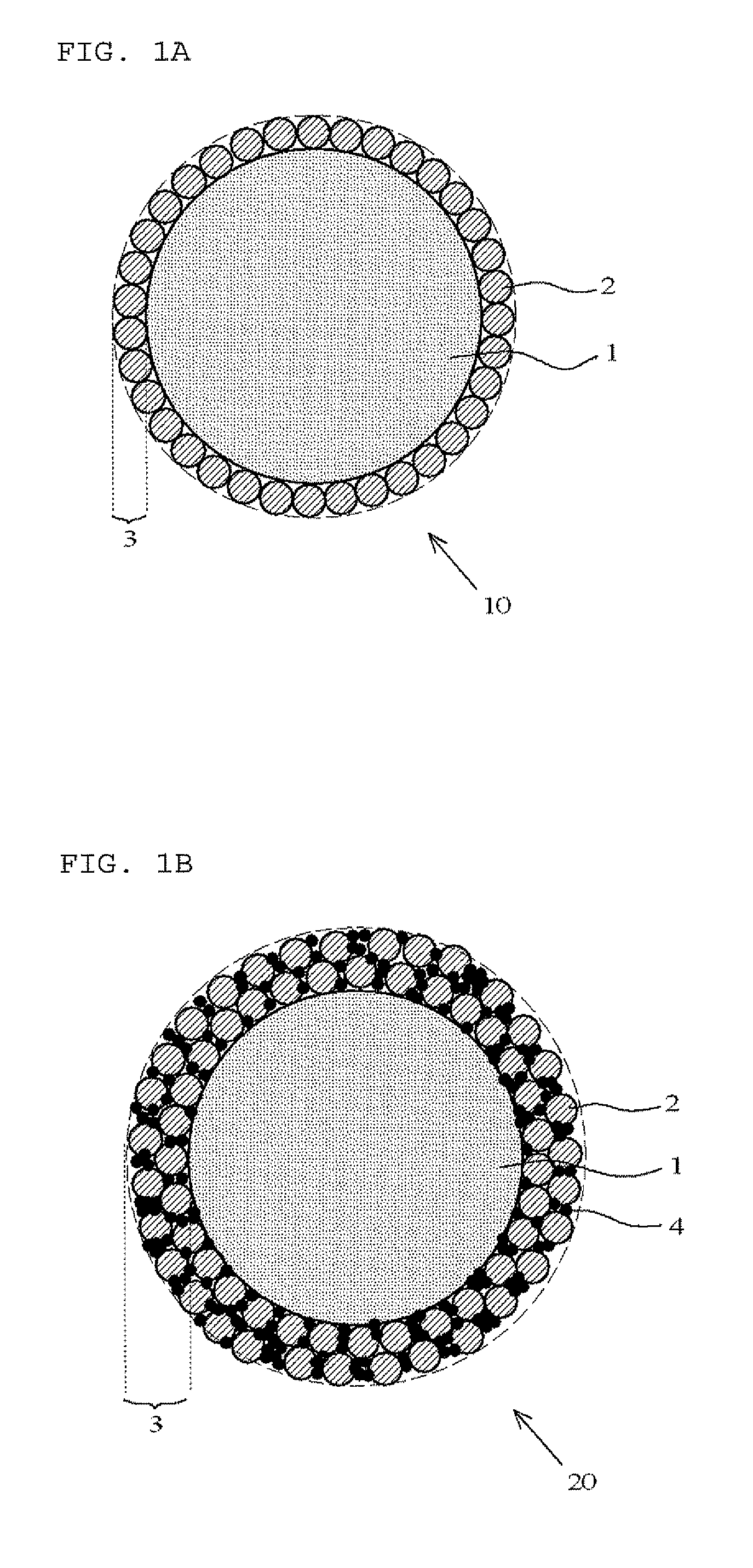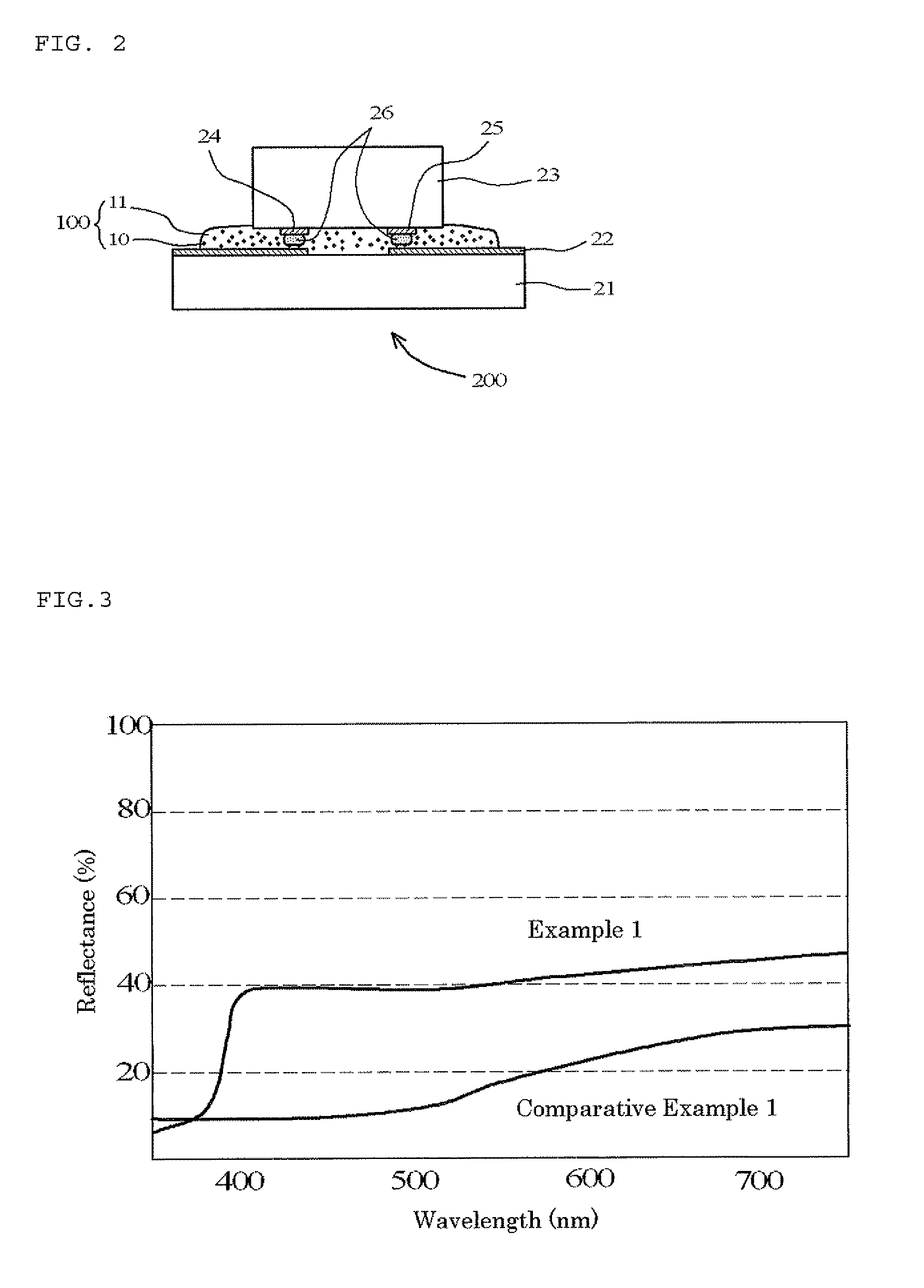Light-reflective conductive particle, anisotropic conductive adhesive and light-emitting device
a technology of anisotropic conductive adhesive and light-emitting device, which is applied in the direction of non-macromolecular adhesive additives, metal/alloy conductors, and conductors, etc., can solve the problems of deteriorating light-emitting efficiency of led elements b>33/b>, and achieve the effect of improving light-emitting efficiency
- Summary
- Abstract
- Description
- Claims
- Application Information
AI Technical Summary
Benefits of technology
Problems solved by technology
Method used
Image
Examples
example 1
(Production of Light-Reflective Conductive Particles)
[0050]The light-reflective conductive particles of Example 1 were obtained by adding 4 parts by mass of a titanium oxide powder having an average particle size of 0.5 μm (KR-380, Titan Kogyo, Ltd.) and 20 parts by mass of Au-coated resin conductive particles having a brown appearance and an average particle size of 5 μm (particles formed by coating a 0.2 μm-thick electroless gold plating on spherical acrylic resin particles having an average particle size of 4.6 μm (Bright 20GNB4.6 EH, Nippon Chemical Industrial Co., Ltd.)) to a mechanofusion apparatus (AMS-GMP, Hosokawa Micron Corporation), and depositing an approximately 0.3 μm-thick light-reflecting layer formed from the titanium oxide particles on the surface of the conductive particles under conditions of a rotation speed of 1,000 rpm and a rotation time of 20 minutes. The appearance of these light-reflective conductive particles was grey.
(Light Reflectance Evaluation Test)
[0...
example 2
[0056]Light-reflective conductive particles having a grey appearance, and an anisotropic conductive adhesive, were obtained in the same manner as in Example 1, except that Ni-coated resin conductive particles having an average particle size of 5.0 μm (52NR-4.6 EH, Nippon Chemical Industrial Co., Ltd.) were used instead of Au-coated resin conductive particles. Further, a light reflectance evaluation test and an electrical properties (continuity reliability, insulation reliability) evaluation test were also carried out in the same manner as in Example 1. The obtained results are shown in Table 1.
example 3
[0057]Light-reflective conductive particles having a grey appearance were obtained by adding 4 parts by mass of a titanium oxide powder having an average particle size of 0.5 μm (KR-380, Titan Kogyo, Ltd.), 3 parts by mass of polystyrene (PS) particles having an average particle size of 0.2 μm (Glossdell 204S, Mitsui Chemicals, Inc.) as adhesive particles, and 20 parts by mass of conductive particles having an average particle size of 5 μm (particles formed by coating a 0.2 μm-thick electroless gold plating on spherical acrylic resin particles having an average particle size of 4.6 μm (Bright 20GNB4.6 EH, Nippon Chemical Industrial Co., Ltd.) to a mechanofusion apparatus (AMS-GMP, Hosokawa Micron Group), and depositing an approximately 1 μm-thick light-reflecting layer formed from styrene and titanium oxide particles on the surface of the conductive particles under conditions of a rotation speed of 1,000 rpm and a rotation time of 20 minutes. Then, an anisotropic conductive adhesive...
PUM
| Property | Measurement | Unit |
|---|---|---|
| refractive index | aaaaa | aaaaa |
| thickness | aaaaa | aaaaa |
| light path length | aaaaa | aaaaa |
Abstract
Description
Claims
Application Information
 Login to View More
Login to View More - R&D
- Intellectual Property
- Life Sciences
- Materials
- Tech Scout
- Unparalleled Data Quality
- Higher Quality Content
- 60% Fewer Hallucinations
Browse by: Latest US Patents, China's latest patents, Technical Efficacy Thesaurus, Application Domain, Technology Topic, Popular Technical Reports.
© 2025 PatSnap. All rights reserved.Legal|Privacy policy|Modern Slavery Act Transparency Statement|Sitemap|About US| Contact US: help@patsnap.com



